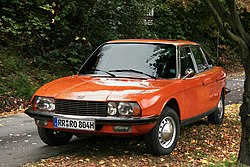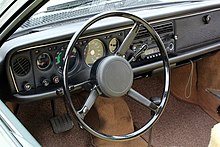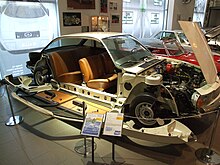NSU Ro 80
| NSU | |
|---|---|
|
NSU Ro 80 (1971-1977)
|
|
| Ro 80 | |
| Production period: | 1967-1977 |
| Class : | upper middle class |
| Body versions : | limousine |
| Engines: |
Wankel engine : 1.0 liter (85 kW) |
| Length: | 4780 mm |
| Width: | 1760 mm |
| Height: | 1410 mm |
| Wheelbase : | 2860 mm |
| Empty weight : | 1280 kg |
The NSU Ro 80 was an upper class sedan from NSU Motorenwerke AG (from 1969: Audi NSU Auto Union AG ), which was manufactured from summer 1967 to mid-1977. It was one of the few series production vehicles with a rotary engine (with an output of 115 hp (85 kW)).
Model history
The Ro 80 appeared in October 1967 with a streamlined body that looked unusual in its time. The Ro 80 was named Car of the Year for 1968 .
The Wankel engine caused problems in the initial phase due to frequent sealing strip defects, which the manufacturer met with accommodating engine replacement. Nevertheless, the reputation of the new model and the Wankel engine suffered considerably.
The Ro 80 was developed under the direction of Ewald Praxl . The body was designed by Claus Luthe . He realized a wedge shape that had a style-defining effect in the automotive design of the 1980s. At Audi in particular, the appearance of the Ro 80 became decisive for entire generations of vehicles. With a width of 1475 mm at the front and rear, the vehicle offered a lot of space inside, the legroom was great - knee room at the rear 170-280 mm, with a seat depth of 475 mm. The trunk could be expanded with separately removable backrests. The 83 liter fuel tank was installed outside the crumple zone in front of the rear axle. The interior noise was low (73 Phon at 100 km / h).
Only 37,406 copies of the Ro 80 were produced by July 1977. Technically, he remained without a successor.
The last mass-produced vehicle was handed over to the Deutsches Museum . Other vehicles are in the Pinakothek der Moderne in Munich, in the depot of the German Museum of Technology in Berlin , in the German Two-Wheeler and NSU Museum and in the Audi Forum in Neckarsulm , in the museum mobile in Ingolstadt, in the EFA Museum for German Automobile History in Amerang as well as exhibited in the Autostadt in Wolfsburg. The cutaway model of the Ro 80, with which the car was presented at the IAA , is shown in the Autovision Museum as part of the permanent Wankel engine exhibition.
The oldest surviving NSU Ro 80 has the chassis no. 80 001 061, production date Thursday, October 19, 1967, color sagunto blue. The last Ro 80 was assembled in 1985 by Heinrich Afflerbach in Kreuztal-Eichen from a body shell and individual parts and was re-registered in 1992 with the manufacturer's entry "Afflerbach".
The "Ro" in the name stands for "rotary piston", in contrast to "K" for "piston" - meaning reciprocating pistons - in the VW K 70 .
Problems with the rotary engine
The first series engines suffered engine damage as a result of a design error. If the engines had lasted over 200,000 km in the test, they often quickly lost compression in customer hands . An incorrect material pairing was soon recognized as the cause. Changed materials and a changed division of the sealing strips were able to solve the problems for the time being. In connection with a Ferro-TiC middle part and a harder Elnisil layer with a higher silicon carbide content, the original sealing strip division was later used. At the beginning of 1970 the new Ferro-TiC sealing strips were introduced into series production.
The double ignition with two spark plugs per chamber also proved to be problematic, on the one hand due to the setting and on the other hand because of the high level of wear and tear on the breaker contacts , which led to engine damage when the ignition point was shifted in the direction of pre-ignition. This was remedied by using only one spark plug per chamber in conjunction with a high-voltage capacitor ignition (HKZ) at the expense of fuel consumption. The accommodating exchange practice meant that over 35% of the allegedly defective motors were OK. After the ignition timing and the carburetor had been reset and the engine had completed a test run on the test bench, these engines were again delivered as exchange engines.
A not inconsiderable proportion of engine damage was due to the torque converter , which was built in to prevent the valve jerking (caused by the peripheral inlet) and which was partly responsible for the additional consumption of the Ro 80. In contrast to reciprocating piston engines, rotary engines could turn very high without the engine noise increasing too much. Occasionally they were unintentionally operated at overspeed. The torque converter expanded radially to such an extent that the pump wheel collided with the turbine wheel. Since the converter was fed from the engine oil circuit, metal chips got into the engine, which immediately led to engine damage. A small needle bearing in the converter also proved to be susceptible, the failure of which also led to chips in the engine oil and thus indirectly to a defective engine. That was fixed with a reinforced converter. From autumn 1971, in conjunction with the new MSI from Bosch , an acoustic speed warning system and the thermal exhaust emission introduced and the speed limit , the electric fuel pump switched off when a high engine speed, preventing further damage to the engine.
Initially, an oil change was planned every 20,000 km , which was later omitted. Many drivers therefore believed that there was no longer any need to top up oil, which resulted in some engines breaking down without oil. This type of engine damage was countered with a modified double-flow oil pump. The inlet for the converter circuit was set higher. Before the engine oil circuit got no more lubricant, the converter circuit sucked in air, whereupon the converter oil pressure dropped and the oil pressure display lit up. If the driver ignored the warning lamp, the converter would no longer transmit a moment to the transmission and the car would come to a halt. At least now the careless driver knew that he had forgotten to check the oil level.
The oil metering pump used initially without a zero stop could also cause engine damage. If the setting was incorrect, this pump would not deliver any oil for lubricating the running surface (trochoid) when idling . Later a modified oil metering pump was used, which could no longer be reset.
Another problem was that several previously untried processes were introduced in connection with the Wankel engine. The elnisil coating of the tread was jokingly said that it only worked in southerly winds, which alluded to its sensitivity to weathering. Initially there were also problems with the dosage and grain size of the embedded silicon carbide and the dosage of saccharine (which is used in electroplating as a leveler for nickel layers). In some cases, the workshops were overwhelmed with the engine-related technology. Some customers also developed downright criminal energy: Shortly before the warranty expired, they deliberately provoked engine damage in order to receive an exchange machine at no cost.
When the sealing strip problem appeared to be resolved, the engine damage increased again. This time, however, this was not due to a design flaw, but to a supplier who did not adhere to the manufacturing regulations.
In the last versions of the Ro 80 rotary engines, the sealing strips were made of Ferro-TiC. They turned out to be consistent. This last version had a long service life and could be operated with unleaded fuel without any problems .
Technical specifications
- Engine : two-disc rotary piston engine (Wankel system) 497.50 cm³ per chamber, compression 9.0: 1.
- Ignition : from 1967 to 1969 double ignition (two candles per chamber), from 1969 to 1977 high-voltage capacitor ignition (HKZ) with one candle
- Mixture preparation : 2 Solex flat-flow register carburettors type 18/32 HHD or double downdraft carburettors Solex 32 DDITS
- Output : 85 kW (115 PS) at 5500 rpm, max. Torque 165 Nm at 4500 rpm
- Body : Self-supporting, front-wheel drive, MacPherson strut axle at the front, semi-trailing arm axle with spring / damper units and additional rubber springs at the rear
- Brakes : hydraulically operated with brake booster and load-dependent brake force regulator on the rear axle, four disc brakes, inside the front of the gearbox; Handbrake: mechanical inner shoe brake acting on rear wheels, 160 mm diameter. Front discs: 284 mm, rear: 272.5 mm diameter. Dual-circuit brake system, first brake circuit on all wheels, second brake circuit only acting on the front wheels
- Transmission : three-speed gear change gearbox , lock-synchronized with parking lock. Hydraulic Fichtel & Sachs torque converter with single-disc clutch, electro-pneumatically operated
- Steering : ZF - rack and pinion steering with circulating oil steering aid ( servo )
- Top speed : approx. 180 km / h
Selling price
- Vehicle price (1973): 17,990.00 DM
- Headrests: DM 110.00
- Automatic seat belts: 185.00 DM
- Color metallic: 425.00 DM
Existence in Germany
According to the KBA, at least 679 vehicles with the type code number of this series were registered as of January 1, 2015. Other sources indicate a stock of “less than 3000 copies” in Germany for the 50th anniversary of the premiere (2017).
Design study
In 1971, the Ro 80 2 Porte +2 study was presented at the Turin Motor Show. This model designed by Pininfarina was to be the successor to the Ro 80, but did not go into series production. Most of the technical data was taken from the Ro 80. The rear doors, which ran in opposite directions, i.e. on the C-pillar , were a special feature . These doors, popularly known as suicide doors, have been banned in Germany since 1961, because if they are opened unintentionally while driving, they are not pushed shut by the airflow, but are suddenly torn open. For this reason, the rear doors of the Ro 80 2 Porte +2 were slightly overlapped by the front doors so that they could only be opened when the front doors were open. Another special feature was the roof, a large part of which could be folded back and placed on the trunk lid. This construction was a forerunner of today's retractable hardtop . The doors have been specially reinforced to improve side impact protection. Volvo took up this idea again in 1991 with its Side Impact Protection System . In 1971, however, the vehicle looked too futuristic, so that development was discontinued.
literature
- Purchase advice in Oldtimer-Markt 3/2011 from p. 42
swell
- ↑ auto motor und sport, issue 3/1968, pp. 25-27.
- ^ NSU Ro 80, 1967. www.audi.de, archived from the original on October 9, 2010 ; Retrieved June 13, 2010 .
- ↑ der-wankelmotor.de: History of NSU , accessed on March 25, 2009.
- ↑ a b c der-wankelmotor.de: The Wankel engine , accessed on March 25, 2009
- ↑ a b c d e Dieter Korp: Protocol of an Invention: The Wankel Engine . Motorbuch Verlag, pages 134-135
- ↑ Ro80 repair manual and supplementary sheets for the repair manual - publisher Audi-NSU
- ↑ Thöne, Carsten; Schmid, Klaus; Metzner, Martin: Influence of saccharine on the internal stresses in nickel layers . In: Galvanotechnik 98 (2007), No. 11, pp. 2650-2652.
- ↑ Passenger car inventory on January 1, 2015 by manufacturer, trade name and selected features. (PDF) In: Statistische Mitteilungen des Kraftfahrt-Bundesamt FZ 2, January 1, 2015. Kraftfahrt-Bundesamt, July 2015, p. 14 , accessed on September 26, 2015 .
- ^ Despised "savior of the German car honor". In: handelsblatt.com . May 3, 2017. Retrieved June 28, 2018 .
- ↑ Thomas Geiger: Limousine with a distinctive sound - 50 years of NSU Ro 80. In: Frankfurter Neue Presse. May 2, 2017. Retrieved June 28, 2018 .










